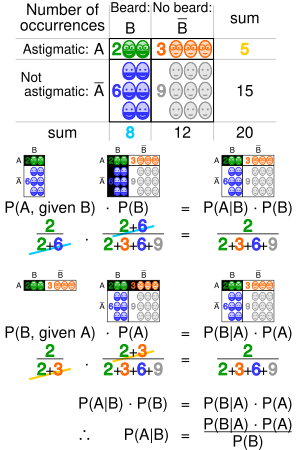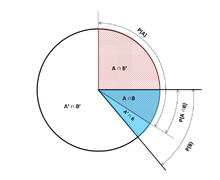Conditional probability
| Part of a series on Statistics |
| Probability theory |
|---|
 |
In probability theory, conditional probability is a measure of the probability of an event (some particular situation occurring) given that (by assumption, presumption, assertion or evidence) another event has occurred.[1] If the event of interest is A and the event B is known or assumed to have occurred, "the conditional probability of A given B", or "the probability of A under the condition B", is usually written as P(A | B), or sometimes PB(A) or P(A / B). For example, the probability that any given person has a cough on any given day may be only 5%. But if we know or assume that the person has a cold, then they are much more likely to be coughing. The conditional probability of coughing by the unwell might be 75%, then: P(Cough | Well) = 5%; P(Cough | Sick) = 75%
The concept of conditional probability is one of the most fundamental and one of the most important in probability theory.[2] But conditional probabilities can be quite slippery and require careful interpretation.[3] For example, there need not be a causal relationship between A and B, and they don’t have to occur simultaneously.
P(A | B) may or may not be equal to P(A) (the unconditional probability of A). If P(A | B) = P(A), then events A and B are said to be "independent": in such a case, knowledge about either event does not give information on the other. P(A | B) (the conditional probability of A given B) typically differs from P(B | A). For example, if a person has dengue they might have a 90% chance of testing positive for dengue. In this case what is being measured is that if event B ("having dengue") has occurred, the probability of A (test is positive) given that B (having dengue) occurred is 90%: that is, P(A | B) = 90%. Alternatively, if a person tests positive for dengue they may have only a 15% chance of actually having this rare disease because the false positive rate for the test may be high. In this case what is being measured is the probability of the event B (having dengue) given that the event A (test is positive) has occurred: P(B | A) = 15%. Falsely equating the two probabilities causes various errors of reasoning such as the base rate fallacy. Conditional probabilities can be reversed using Bayes' theorem.
Conditional probabilities can be displayed in a conditional probability table.
Contents
Definition[edit]


Conditioning on an event[edit]
Kolmogorov definition[edit]
Given two events A and B, from the sigma-field of a probability space, with the unconditional probability of B (that is, of the event B occurring ) being greater than zero – P(B) > 0 – the conditional probability of A given B is defined as the quotient of the probability of the joint of events A and B, and the probability of B[4]:
where is the probability that both events A and B occur. This may be visualized as restricting the sample space to situations in which B occurs. The logic behind this equation is that if the possible outcomes for A and B are restricted to those in which B occurs, this set serves as the new sample space.
Note that this is a definition but not a theoretical result. We just denote the quantity as and call it the conditional probability of A given B.
As an axiom of probability[edit]
Some authors, such as de Finetti, prefer to introduce conditional probability as an axiom of probability:
Although mathematically equivalent, this may be preferred philosophically; under major probability interpretations such as the subjective theory, conditional probability is considered a primitive entity. Further, this "multiplication axiom" introduces a symmetry with the summation axiom for mutually exclusive events:[5]
As the probability of a conditional event[edit]
Conditional probability can be defined as the probability of a conditional event [6]. Assuming that the experiment underlying the events and is repeated, the Goodman–Nguyen–van Fraassen conditional event can be defined as
It can be shown that
which meets the Kolmogorov definition of conditional probability. Note that the equation is a theoretical result and not a definition. The definition via conditional events can be understood directly in terms of the Kolmogorov axioms and is particularly close to the Kolmogorov interpretation of probability in terms of experimental data. For example, conditional events can be repeated themselves leading to a generalized notion of conditional event . It can be shown[6] that the sequence is i.i.d., which yields a strong law of large numbers for conditional probability:
Measure-theoretic definition[edit]
If P(B) = 0, then according to the simple definition, P(A|B) is undefined. However, it is possible to define a conditional probability with respect to a σ-algebra of such events (such as those arising from a continuous random variable).
For example, if X and Y are non-degenerate and jointly continuous random variables with density ƒX,Y(x, y) then, if B has positive measure,
The case where B has zero measure is problematic. For the case that B = {y0}, representing a single point, the conditional probability could be defined as
however this approach leads to the Borel–Kolmogorov paradox. The more general case of zero measure is even more problematic, as can be seen by noting that the limit, as all δyi approach zero, of
depends on their relationship as they approach zero. See conditional expectation for more information.
Conditioning on a random variable[edit]
Let X be a random variable; we assume for the sake of presentation that X is discrete, that is, X takes on only finitely many values x. Let A be an event. The conditional probability of A given X is defined as the random variable, written P(A|X), that takes on the value
whenever
More formally,
The conditional probability P(A|X) is a function of X: e.g., if the function g is defined as
then
Note that P(A|X) and X are now both random variables. From the law of total probability, the expected value of P(A|X) is equal to the unconditional probability of A.
Partial conditional probability[edit]
The partial conditional probability is about the probability of event given that each of the condition events has occurred to a degree (degree of belief, degree of experience) that might be different from 100%. Frequentistically, partial conditional probability makes sense, if the conditions are tested in experiment repetitions of appropriate length [7]. Such -bounded partial conditional probability can be defined as the conditionally expected average occurrence of event in testbeds of length that adhere to all of the probability specifications , i.e.:
Based on that, partial conditional probability can be defined as
where [7]
Jeffrey conditionalization [8] [9] is a special case of partial conditional probability in which the condition events must form a partition:
Example[edit]
Suppose that somebody secretly rolls two fair six-sided dice, and we wish to compute the probability that the face-up value of the first one is 2, given the information that their sum is no greater than 5.
Probability that D1 = 2
Table 1 shows the sample space of 36 combinations of rolled values of the two dice, each of which occurs probability 1/36, with the numbers displayed in the red and dark gray cells being D1 + D2.
D1 = 2 in exactly 6 of the 36 outcomes; thus P(D1 = 2) = 6⁄36 = 1⁄6:
Table 1 + D2 1 2 3 4 5 6 D1 1 2 3 4 5 6 7 2 3 4 5 6 7 8 3 4 5 6 7 8 9 4 5 6 7 8 9 10 5 6 7 8 9 10 11 6 7 8 9 10 11 12
Probability that D1 + D2 ≤ 5
Table 2 shows that D1 + D2 ≤ 5 for exactly 10 of the 36 outcomes, thus P(D1 + D1 ≤ 5) = 10⁄36:
Table 2 + D2 1 2 3 4 5 6 D1 1 2 3 4 5 6 7 2 3 4 5 6 7 8 3 4 5 6 7 8 9 4 5 6 7 8 9 10 5 6 7 8 9 10 11 6 7 8 9 10 11 12
Probability that D1 = 2 given that D1 + D2 ≤ 5
Table 3 shows that for 3 of these 10 outcomes, D1 = 2.
Thus, the conditional probability P(D1 = 2 | D1+D2 ≤ 5) = 3⁄10 = 0.3:
Table 3 + D2 1 2 3 4 5 6 D1 1 2 3 4 5 6 7 2 3 4 5 6 7 8 3 4 5 6 7 8 9 4 5 6 7 8 9 10 5 6 7 8 9 10 11 6 7 8 9 10 11 12
Here, in the earlier notation for the definition of conditional probability, the conditioning event B is that D1 + D2 ≤ 5, and the event A is D1 = 2. We have as seen in the table.
Use in inference[edit]
In statistical inference, the conditional probability is an update of the probability of an event based on new information.[3] Incorporating the new information can be done as follows:[1]
- Let A, the event of interest, be in the sample space, say (X,P).
- The occurrence of the event A knowing that event B has or will have occurred, means the occurrence of A as it is restricted to B, i.e. .
- Without the knowledge of the occurrence of B, the information about the occurrence of A would simply be P(A)
- The probability of A knowing that event B has or will have occurred, will be the probability of relative to P(B), the probability that B has occurred.
- This results in whenever P(B) > 0 and 0 otherwise.
This approach results in a probability measure that is consistent with the original probability measure and satisfies all the Kolmogorov axioms. This conditional probability measure also could have resulted by assuming that the relative magnitude of the probability of A with respect to X will be preserved with respect to B (cf. a Formal Derivation below).
The wording "evidence" or "information" is generally used in the Bayesian interpretation of probability. The conditioning event is interpreted as evidence for the conditioned event. That is, P(A) is the probability of A before accounting for evidence E, and P(A|E) is the probability of A after having accounted for evidence E or after having updated P(A). This is consistent with the frequentist interpretation, which is the first definition given above.
Statistical independence[edit]
Events A and B are defined to be statistically independent if
If P(B) is not zero, then this is equivalent to the statement that
Similarly, if P(A) is not zero, then
is also equivalent. Although the derived forms may seem more intuitive, they are not the preferred definition as the conditional probabilities may be undefined, and the preferred definition is symmetrical in A and B.
Independent events vs. mutually exclusive events
The concepts of mutually independent events and mutually exclusive events are separate and distinct. The following table contrasts results for the two cases (provided the probablity of the conditioning event is not zero).
| If statistically independent | If mutually exclusive | |
|---|---|---|
| 0 | ||
| 0 | ||
| 0 |
In fact, mutually exclusive events cannot be statistically independent (unless they both are impossible), since knowing that one occurs gives information about the other (specifically, that it certainly does not occur).
Common fallacies[edit]
- These fallacies should not be confused with Robert K. Shope's 1978 "conditional fallacy", which deals with counterfactual examples that beg the question.
Assuming conditional probability is of similar size to its inverse[edit]

In general, it cannot be assumed that P(A|B) ≈ P(B|A). This can be an insidious error, even for those who are highly conversant with statistics.[10] The relationship between P(A|B) and P(B|A) is given by Bayes' theorem:
That is, P(A|B) ≈ P(B|A) only if P(B)/P(A) ≈ 1, or equivalently, P(A) ≈ P(B).
Assuming marginal and conditional probabilities are of similar size[edit]
In general, it cannot be assumed that P(A) ≈ P(A|B). These probabilities are linked through the law of total probability:
where the events form a countable partition of .
This fallacy may arise through selection bias.[11] For example, in the context of a medical claim, let SC be the event that a sequela (chronic disease) S occurs as a consequence of circumstance (acute condition) C. Let H be the event that an individual seeks medical help. Suppose that in most cases, C does not cause S so P(SC) is low. Suppose also that medical attention is only sought if S has occurred due to C. From experience of patients, a doctor may therefore erroneously conclude that P(SC) is high. The actual probability observed by the doctor is P(SC|H).
Over- or under-weighting priors[edit]
Not taking prior probability into account partially or completely is called base rate neglect. The reverse, insufficient adjustment from the prior probability is conservatism.
Formal derivation[edit]
Formally, P(A | B) is defined as the probability of A according to a new probability function on the sample space, such that outcomes not in B have probability 0 and that it is consistent with all original probability measures.[12][13]
Let Ω be a sample space with elementary events {ω}. Suppose we are told the event B ⊆ Ω has occurred. A new probability distribution (denoted by the conditional notation) is to be assigned on {ω} to reflect this. For events in B, it is reasonable to assume that the relative magnitudes of the probabilities will be preserved. For some constant scale factor α, the new distribution will therefore satisfy:
Substituting 1 and 2 into 3 to select α:
So the new probability distribution is
Now for a general event A,
See also[edit]
- Borel–Kolmogorov paradox
- Chain rule (probability)
- Class membership probabilities
- Conditional probability distribution
- Conditioning (probability)
- Joint probability distribution
- Monty Hall problem
- Posterior probability
- Bayes' theorem
References[edit]
- ^ a b Gut, Allan (2013). Probability: A Graduate Course (Second ed.). New York, NY: Springer. ISBN 978-1-4614-4707-8.
- ^ Ross, Sheldon (2010). A First Course in Probability (8th ed.). Pearson Prentice Hall. ISBN 978-0-13-603313-4.
- ^ a b Casella, George; Berger, Roger L. (2002). Statistical Inference. Duxbury Press. ISBN 0-534-24312-6.
- ^ Kolmogorov, Andrey (1956), Foundations of the Theory of Probability, Chelsea
- ^ Gillies, Donald (2000); "Philosophical Theories of Probability"; Routledge; Chapter 4 "The subjective theory"
- ^ a b Draheim, Dirk (2017). "An Operational Semantics of Conditional Probabilities that Fully Adheres to Kolmogorov's Explication of Probability Theory". doi:10.13140/RG.2.2.10050.48323/3.
- ^ a b c Draheim, Dirk (2017). "Generalized Jeffrey Conditionalization (A Frequentist Semantics of Partial Conditionalization)". Springer. Retrieved December 19, 2017.
- ^ Jeffrey, Richard C. (1983), The Logic of Decision, 2nd edition, University of Chicago Press
- ^ "Bayesian Epistemology". Stanford Encyclopedia of Philosophy. 2017. Retrieved December 29, 2017.
- ^ Paulos, J.A. (1988) Innumeracy: Mathematical Illiteracy and its Consequences, Hill and Wang. ISBN 0-8090-7447-8 (p. 63 et seq.)
- ^ Thomas Bruss, F; Der Wyatt Earp Effekt; Spektrum der Wissenschaft; March 2007
- ^ George Casella and Roger L. Berger (1990), Statistical Inference, Duxbury Press, ISBN 0-534-11958-1 (p. 18 et seq.)
- ^ Grinstead and Snell's Introduction to Probability, p. 134
External links[edit]
| Wikimedia Commons has media related to Conditional probability. |
- Weisstein, Eric W. "Conditional Probability". MathWorld.
- F. Thomas Bruss Der Wyatt-Earp-Effekt oder die betörende Macht kleiner Wahrscheinlichkeiten (in German), Spektrum der Wissenschaft (German Edition of Scientific American), Vol 2, 110–113, (2007).
- Visual explanation of conditional probability


















![{\displaystyle P(X\in A\mid Y\in \bigcup _{i}[y_{i},y_{i}+\delta y_{i}])\approxeq {\frac {\sum _{i}\int _{x\in A}f_{X,Y}(x,y_{i})\,dx\,\delta y_{i}}{\sum _{i}\int _{x\in \mathbb {R} }f_{X,Y}(x,y_{i})\,dx\,\delta y_{i}}},}](https://wikimedia.org/api/rest_v1/media/math/render/svg/26f127ee4281f3096623f1808477d47e2d60ad01)































![{\displaystyle {\begin{aligned}1&=\sum _{\omega \in \Omega }{P(\omega \mid B)}\\&=\sum _{\omega \in B}{P(\omega \mid B)}+{\cancelto {0}{\sum _{\omega \notin B}P(\omega \mid B)}}\\&=\alpha \sum _{\omega \in B}{P(\omega )}\\[5pt]&=\alpha \cdot P(B)\\[5pt]\Rightarrow \alpha &={\frac {1}{P(B)}}\end{aligned}}}](https://wikimedia.org/api/rest_v1/media/math/render/svg/bc21b49c38af5566aeb4794016be9ee06b40458c)

![{\displaystyle {\begin{aligned}P(A\mid B)&=\sum _{\omega \in A\cap B}{P(\omega \mid B)}+{\cancelto {0}{\sum _{\omega \in A\cap B^{c}}P(\omega \mid B)}}\\&=\sum _{\omega \in A\cap B}{\frac {P(\omega )}{P(B)}}\\[5pt]&={\frac {P(A\cap B)}{P(B)}}\end{aligned}}}](https://wikimedia.org/api/rest_v1/media/math/render/svg/4f6e98f9200e5cf74a15231fc3c753ccfeb8d1c6)